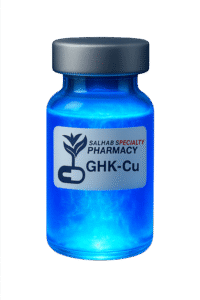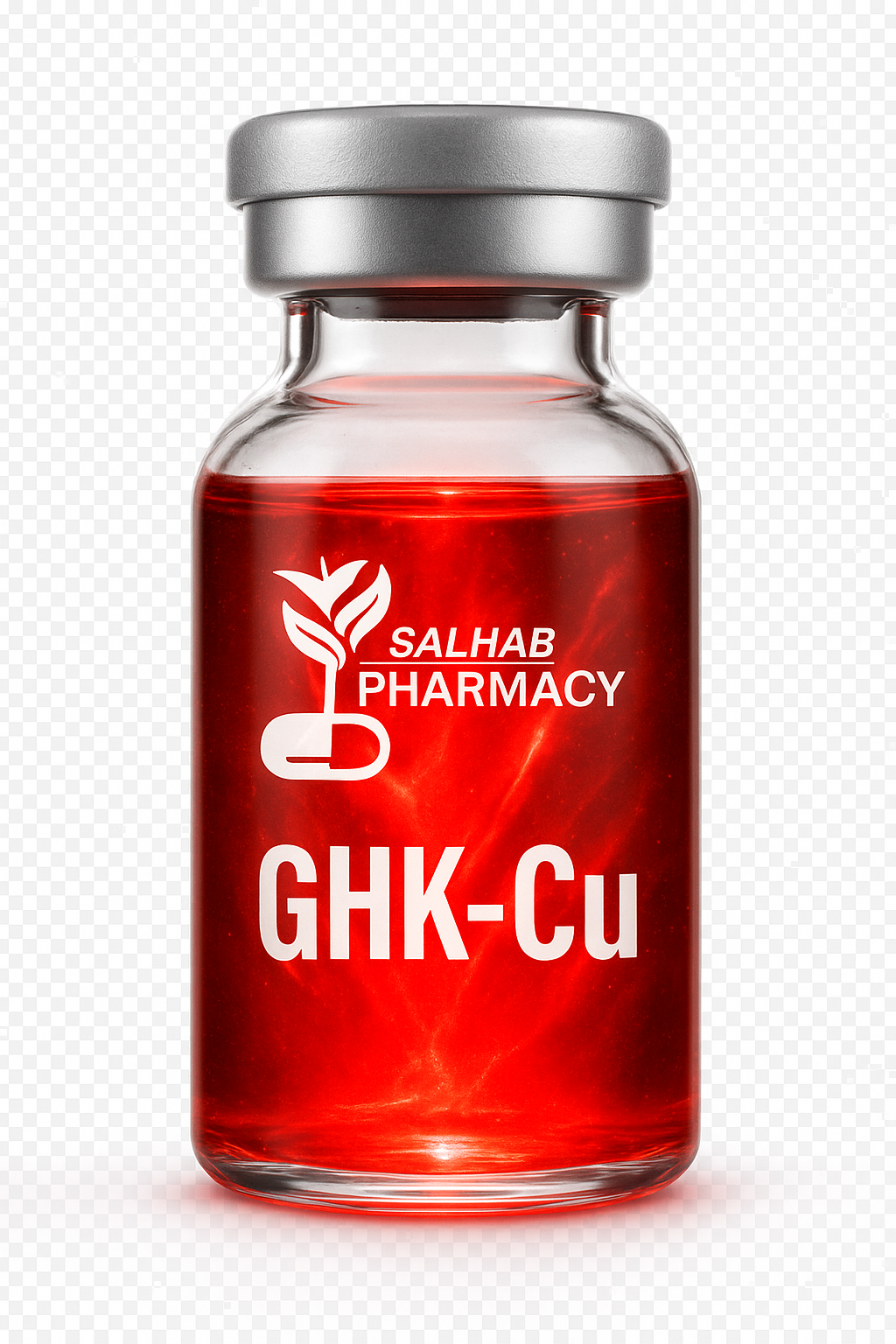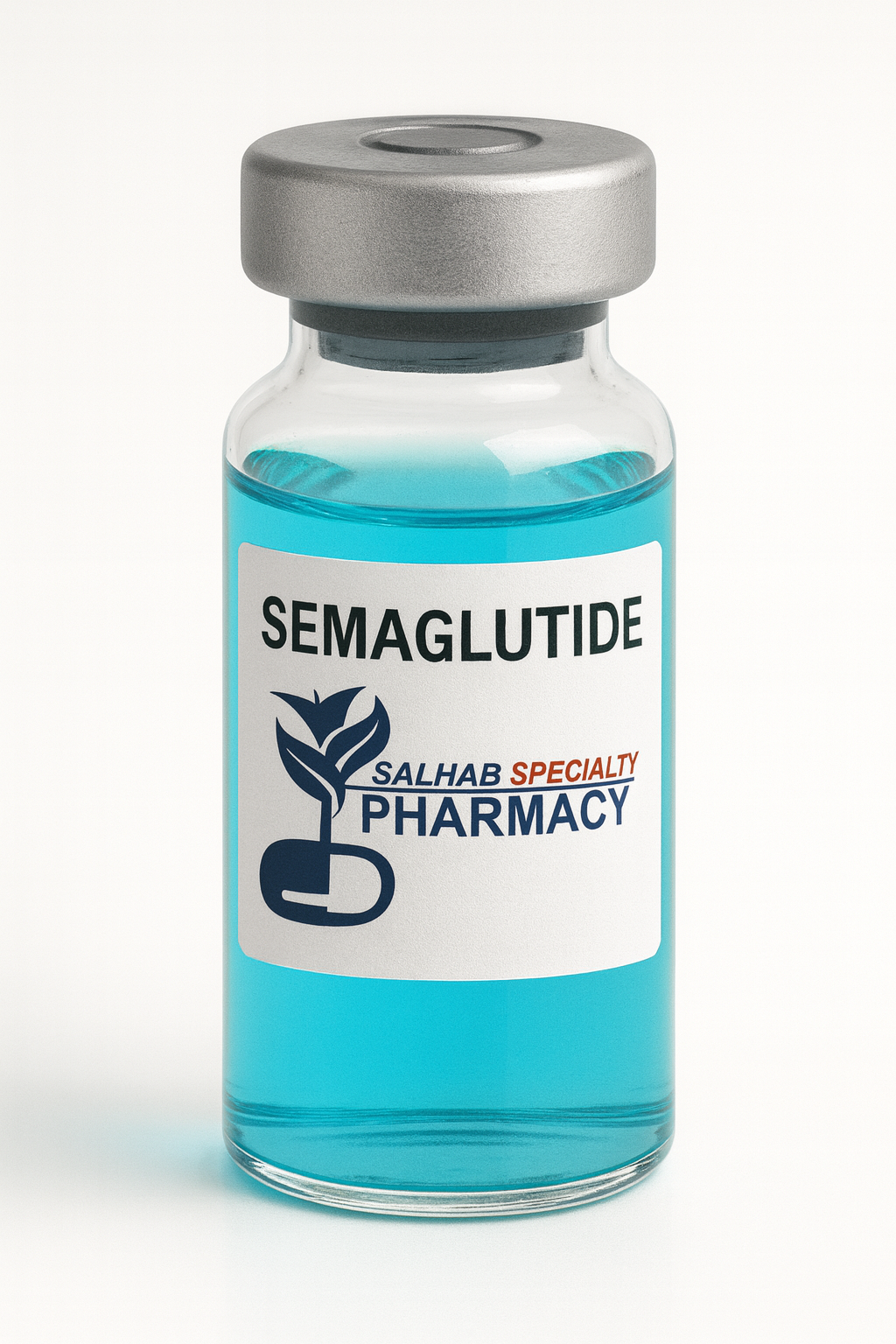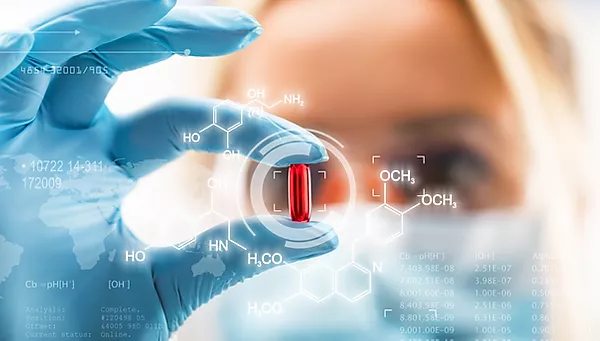
GHK Cu (glycyl-L-histidyl-L-lysine copper peptide-1) is a naturally occurring copper peptide that has gained attention for its regenerative and anti-aging properties. It is available for sale in skincare formulations, serums, and compounding solutions, including options offered by pharmacies like Salhab Pharmacy. Originally discovered in the 1970s as a “liver growth factor,” GHK by itself and when bound to copper has been studied for wound healing, skin rejuvenation, and hair restoration. As GHK Cu sales grow, consumers can find it in products labeled as copper tripeptide-1 or GHK-Cu. This article explores GHK Cu’s biological roles, benefits, therapeutic uses, and practical guidance for patients and practitioners, helping you understand why GHK Cu products for sale might be worth considering.
Biological Role and Mechanisms of Action
GHK is a tripeptide (glycine-histidine-lysine) that circulates in human blood and other tissues. It binds copper ions (Cu^2+), forming GHK-Cu, which acts as a carrier to deliver copper into cells. Copper is a vital cofactor for many enzymes (e.g. superoxide dismutase, lysyl oxidase) involved in collagen formation, antioxidant defense, and tissue repair. In this way, GHK Cu helps regulate important biochemical processes:
Collagen and extracellular matrix (ECM) remodeling: GHK Cu stimulates skin fibroblasts to produce more collagen, elastin, and glycosaminoglycans, strengthening skin structure
It also upregulates decorin, a proteoglycan that helps organize collagen fibers, improving skin firmness
Antioxidant and anti-inflammatory effects: The copper in GHK Cu supports antioxidant enzymes and inhibits free radical damage. GHK Cu also can reduce inflammatory cytokines (like TNF-α) at wound sites
Growth factor stimulation: GHK Cu induces expression of growth factors (e.g. VEGF) that enhance blood vessel formation (angiogenesis), critical for wound healing and skin regeneration
Gene modulation: Remarkably, GHK-Cu can modulate gene expression. Studies show it upregulates genes involved in skin repair and downregulates genes linked to inflammation and even metastasis
This gene-level effect is part of why GHK Cu is sometimes called a “molecular switch” for tissue recovery.
Regulated remodeling: GHK Cu not only promotes synthesis of matrix components but also balances their breakdown. It increases both matrix metalloproteinases (enzymes that degrade collagen) and their inhibitors, coordinating skin remodeling
This suggests careful dosing is needed so the peptide supports healthy renewal without excessive degradation.
Overall, GHK Cu acts as a natural modulator of tissue health. As a small peptide, it penetrates easily into tissues, ferrying copper to cells and receptors to trigger repair pathways. Its multifaceted mechanisms underlie the anti-aging and regenerative effects reported in research and user experiences.
Uses and Benefits of GHK Cu
GHK Cu’s primary use today is in skin care and aesthetic therapies. Key benefits that have been observed or proposed include:
Enhanced collagen production: GHK Cu stimulates fibroblasts to ramp up collagen and elastin synthesis, which improves skin firmness and elasticity
This helps reduce wrinkles and makes sagging skin appear tighter over time.
Skin rejuvenation: By increasing skin thickness and density, GHK Cu can smooth fine lines and rough texture. Clinical trials reported women using GHK Cu creams daily for months saw significantly thicker skin and fewer wrinkles than those using vitamin K or placebo.
Wound healing: GHK Cu accelerates wound closure and scar formation. In animal studies it improved wound contraction and granulation tissue growth, and increased collagen and antioxidant levels in healing skin
Hair growth: GHK Cu promotes hair thickness and regrowth. It enlarges miniaturized hair follicles and prolongs the anagen (growth) phase of hair cycles. It also stimulates scalp circulation (via VEGF) and supports dermal papilla cells, creating a healthier environment for hair
Anti-inflammatory and antioxidant: The peptide carries copper to superoxide dismutase and other defenses, protecting skin from UV and free radicals
. It also reduces redness and soothes irritation by dampening inflammatory signals.
Barrier repair: By boosting proteins that form the skin barrier (like collagen and other matrix molecules), GHK Cu helps strengthen the skin’s natural defense against moisture loss and environmental stress
Scar reduction: GHK Cu may improve the appearance of scars by balancing collagen deposition. Some studies suggest it can modulate hypertrophic scarring processes, making skin smoother over lesions.
Miscellaneous effects: Research hints at other benefits, including possible anti-pain effects (in animal models) and even tumor-suppressing actions by downregulating metastasis-related genes. However, these are more experimental at present.
Clinically, GHK Cu benefits often take weeks to months to appear. Patients are advised that consistent daily use (for topical products) is needed to see firming and wrinkle-reduction effects. Many users report smoother, more radiant skin and fuller hair after 3–6 months of use. Summarizing key benefits, GHK Cu is known to:
- Stimulate collagen and elastin production (improving skin elasticity and reducing wrinkles).
- Increase skin thickness and firmness, reversing age-related thinning of the dermis
- Accelerate wound healing and tissue repair, aiding recovery from cuts, burns, and post-surgical scars.
- Promote hair growth and thickness by strengthening follicles and enhancing scalp health
- Reduce inflammation and oxidative damage, protecting the skin from environmental stress
- Improve skin clarity by fading hyperpigmentation and blotchy sun spots (due to gentle renewal of skin tissue).
While many of these benefits are backed by lab and small clinical studies
, it’s important to note that GHK Cu is not a magic cure-all. Results can vary by individual, and no single study guarantees every effect. Still, the weight of research suggests GHK Cu is a potent peptide therapy for skin and hair health when used appropriately.
Clinical Applications and Therapies
In clinical and medical settings, GHK Cu is used in several ways to harness its regenerative properties:
Topical treatments (OTC and prescription): The most common application is as an ingredient in anti-aging creams, serums, and gels. These products usually contain 0.05%–3% GHK-Cu (0.5–30 mg/mL). Higher concentrations (up to 20-30%) are sometimes provided in compounded formulas for more intensive treatment
. Clinicians recommend applying a GHK Cu serum or cream daily to wrinkles, scars, or thinning skin to gradually improve appearance. Topical GHK Cu is generally well-tolerated and can often be used alongside other skincare treatments.
Compounded formulations: Pharmacists can compound custom GHK Cu products, mixing the peptide powder with carriers. For example, combinations like GHK-Cu with Argireline and Hyaluronic Acid (popular “peptide cocktails”) are used for wrinkles. Typical compounded gels might contain 0.2% GHK-Cu with other peptides for targeted anti-aging
. Salhab Pharmacy, for instance, offers custom compounding of GHK Cu with hyaluronic acid or other actives tailored to patient needs.
Injectable administration: In some clinics, GHK Cu is prepared as an injectable solution. Doses used include a 10 mg/mL GHK-Cu solution administered subcutaneously (~2 mg per 0.2 mL injection daily)
. When injected, GHK Cu can have more immediate effects on tissue renewal and is sometimes combined with IV therapies for systemic rejuvenation. This should only be done under medical supervision. The figure below shows a clinician preparing an injectable peptide solution:
Figure: A healthcare professional drawing a GHK-Cu peptide solution for injection. Precise dosing and sterile technique are essential in injectable peptide therapy.
Wound care products: GHK Cu has been incorporated into advanced wound dressings. For example, collagen matrices impregnated with GHK-Cu accelerate healing of diabetic ulcers and burns
. These applications leverage GHK Cu’s ability to stimulate angiogenesis and collagen. Such products may be used in hospitals or specialty wound clinics.
Cosmetic procedures: Some aesthetic practices use microneedling or laser resurfacing followed by topical GHK Cu application. The microneedling creates micro-injuries, and adding GHK-Cu can amplify collagen induction. Dermatologists report that combining GHK Cu serums with fractional laser or microneedling often yields better skin tightening than either treatment alone.
Hair restoration treatments: GHK Cu is being used as part of hair-loss regimens. Topical foams (often 0.05%) are applied to the scalp, sometimes using a nightly routine
. It can also be injected into the scalp (like PRP) or used with other growth factors. Some hair surgeons recommend GHK Cu for post-transplant graft support, as its tissue-repair properties aid healing and graft survival
.
Oral supplements (experimental): Researchers have explored oral GHK Cu formulations (e.g. liposomal tablets of 10–20 mg) to systemically boost peptide levels
. However, oral bioavailability of peptides is challenging. To date, no solid evidence confirms efficacy of oral GHK Cu, and it remains an experimental approach.
Formulations for sale therefore cover a wide spectrum: creams, serums, shampoos, lotions, injectable vials, and even bulk peptide powders. Table 1 summarizes typical formulations and uses:
Formulation Typical GHK-Cu Content Common Use/Indication
Topical serum or cream 0.05%–3% (0.5–30 mg/mL) Daily skin care (anti-aging, wrinkles, scars)
Scalp serum or foam 0.1%–0.5% (1–5 mg/mL) Hair growth and scalp health
Injectable solution (compounded) 10 mg/mL (0.1%) in sterile solution Subcutaneous injection (tissue repair, rejuvenation)
Peptide powder (lyophilized) Bulk peptide for reconstitution Compounding of creams or injectables
Shampoo/additive Drop-in (~5–10 mg/mL when diluted) Routine scalp maintenance, thinning hair
Advanced wound dressing Incorporated into collagen matrix Chronic wound healing (ulcers, burns)
Oral (experimental) 10–30 mg (liposomal capsule) Systemic anti-aging (not proven)
Each form has pros and cons. Topicals are easy and safe, but may take longer to show results. Injectables deliver peptide deep in tissues quickly, but require medical procedures. Salhab Pharmacy stocks a range of GHK Cu products in these forms and can advise on the best approach for each goal.
Skin, Hair, and Tissue Effects
Skin Rejuvenation: GHK Cu’s most popular application is in facial and body skincare. By feeding copper into skin cells, it promotes collagen-rich dermal regeneration. Clinical studies show that regular use of GHK Cu creams can increase skin density and thickness. For instance, women with sun-damaged skin saw significant wrinkle reduction and firmer dermis after three months of daily GHK Cu cream
. Users often report gradual smoothing of fine lines around the eyes and mouth. GHK Cu can also improve skin tone and clarity: it may lighten age spots and even out discoloration by encouraging skin turnover, similar to a gentler, peptide-powered peel.
Hair and Scalp: GHK Cu positively affects hair follicles. By enlarging miniaturized follicles and extending the growth phase, it can increase hair count and thickness over time
. Practical routines include applying a GHK Cu serum (0.2–1%) directly to thinning areas twice daily, and even adding it to shampoo. Dermatology reviews note that combining GHK Cu with microneedling greatly boosts its penetration, making follicles more responsive
. Patients using GHK Cu for hair typically see reduced shedding within 1–2 months and noticeable regrowth in 3–6 months of consistent use
Tissue Repair and Wound Healing: In wounds and surgical recovery, GHK Cu acts as a repair stimulant. Its ability to increase granulation tissue, vascular growth, and collagen deposition speeds up healing in animal models
. For patients with injuries or ulcers, topical GHK Cu formulations (often 2–4%) have been used to improve scar healing and reduce chronic inflammation at the site. Salhab Pharmacy’s compounding lab can create GHK Cu ointments or patches for wound care under physician guidance. Anecdotally, some diabetic patients see better healing of ulcers when GHK Cu is applied, though enzyme-rich “wound fluids” can degrade the peptide over time
Overall Tissue Effects: Beyond skin and hair, GHK Cu influences other tissues via gene expression changes. For example, in lab studies it helped lung fibroblasts recover in COPD models
. It also exerts mild analgesic effects, possibly due to similarities with histamine blockers
. These broader systemic effects are still under investigation.
In summary, GHK Cu acts as a multi-purpose tissue remodeler. In skin it plumps and smooths; in hair it thickens and restores; in injuries it speeds recovery. While not all effects are dramatic or immediate, regular use of GHK Cu products can lead to healthier, more resilient skin and hair.
Patient and Practitioner Insights
Patients and practitioners describe complementary perspectives on using GHK Cu:
Patient Experiences: Many users report that patience and consistency are key. A typical patient story might note: “After 8–12 weeks of daily application of a GHK Cu serum, my skin felt noticeably firmer and more hydrated. Lines around my eyes softened.” Another common observation is improved scalp health: “I added GHK Cu drops to my shampoo twice a week, and within a few months I saw new baby hairs along the hairline and less shedding.” Some patients value that GHK Cu is gentle; when compared to retinoids, for instance, they notice fewer irritation issues. However, users also caution that results vary – while some see marked change, others perceive only subtle improvements unless combined with other treatments like antioxidants or dermal rollers.
Practitioner Perspectives: Dermatologists and compounding pharmacists often view GHK Cu as a valuable adjunct, not a standalone miracle. Many recommend starting patients on moderate concentrations (around 0.1%–0.5% topically) to assess tolerance, then adjusting as needed. For wrinkles, clinicians sometimes combine GHK Cu with other peptides (like Argireline or Matrixyl) or growth factors to enhance effects. In hair clinics, doctors might inject GHK Cu near follicles or pair it with PRP (platelet-rich plasma) therapy. A practitioner at Salhab Pharmacy notes that GHK Cu is particularly helpful in “accelerating healing post-procedure” – for example, after microneedling or laser resurfacing, applying GHK Cu can reduce recovery time.
In terms of safety, most dermatologists highlight that topical GHK Cu is well-tolerated by most skin types. They advise patients to perform a patch test before full use (especially on sensitive skin) to check for any allergic reaction. If mild redness or tingling occurs, it usually subsides quickly and is not a concern. Severe reactions are rare.
Practitioner Tips: Experienced users suggest the following best practices:
Start with low concentration: Begin with a 0.1% serum and gradually build up, as higher doses (1–3%) are intended for prescription or professional use.
Apply to clean skin: GHK Cu is more effective when applied after gentle cleansing, so it penetrates unimpeded.
Combine therapies: To maximize results, use GHK Cu in conjunction with good nutrition (copper is also obtained from diet), adequate hydration, and other skin therapies.
Consult experts: Because formulations vary, discussing GHK Cu use with a pharmacist or dermatologist can ensure the right product and regimen. Salhab Pharmacy’s team, for instance, offers consultations on peptide therapies and can compound a product with the ideal carrier (cream, gel, serum) for each patient.
Overall, feedback from real-world use is cautiously optimistic: patients tend to appreciate GHK Cu for its gentleness and long-term benefits, while practitioners value its science-backed effects. It is widely regarded as “low-risk, potential-reward” – meaning it’s safe enough to try for general skin care and healing, though one should manage expectations and use it as part of a comprehensive plan.
Safety, Considerations, and Recommendations
GHK Cu is generally safe and well-tolerated when used appropriately, but some precautions apply:
General Safety: GHK Cu is naturally present in the body and has a long history of use in wound healing and cosmetics. Studies describe it as non-toxic at normal doses
. Topical GHK Cu in concentrations up to 1–3% is usually safe for daily skin or scalp use. Patients seldom report serious side effects.
Patch Testing: As with any new topical product, it’s wise to patch-test: apply a small amount of the GHK Cu cream or serum to a discreet area (like the inner arm) for several days. Watch for any signs of allergy or irritation. If the skin remains calm (only mild redness or itch that quickly subsides), it’s generally fine to proceed. If a severe reaction occurs (rash, swelling, blistering), discontinue use immediately. Always read the ingredient list—sometimes sensitization comes from preservatives or fragrances in the formula, not the peptide itself.
Common Reactions: Most reported side effects are mild and temporary. These include transient redness, itching, or slight tingling at the application site
. Rarely, people might notice a minor increase in breakouts (often called “copper uglies,” due to copper’s effect on sweat glands). Any such effects typically resolve after a week or two. Using a gentle, pH-balanced cleanser and moisturizers alongside GHK Cu can minimize irritation.
Avoiding Excess Copper: GHK Cu introduces copper, but the amounts in topical products are low. Nevertheless, people should avoid applying it near broken skin (except in designated wound-healing products) to prevent systemic absorption. Refrain from taking high-dose copper supplements concurrently unless directed by a physician, to avoid copper overload. Symptoms of copper toxicity (if it were to occur) include stomach upset, headache, and metallic taste, but this is extremely unlikely from skin creams. Still, it’s wise to follow product instructions and not overuse.
Contraindications:
Pregnancy and breastfeeding: There is no definitive research on GHK Cu’s safety in pregnancy or nursing. While it is naturally occurring in the body, its effects on a developing fetus or infant are unknown. Therefore, pregnant or nursing women should consult a healthcare provider before using GHK Cu products.
Active cancer or tumor concerns: Because GHK Cu can stimulate growth factors and angiogenesis, oncology experts advise caution. Patients with active cancer or history of tumors are often recommended to avoid anabolic substances. If you have or had cancer, discuss GHK Cu use with your doctor.
Autoimmune or immune conditions: GHK Cu has immune-modulating effects; people with immune system disorders should use it under guidance, though no specific contraindications are known.
FDA and Regulatory Notes: In the United States, GHK-Cu is recognized in FDA compounding guidance. It is listed as a bulk drug substance for topical and oral use under 503A (Category 1 – under evaluation) but injectable forms were placed in Category 2 (meaning limited or no safety data) as of 2023
. In practice, this means topical GHK Cu is more broadly available and considered safer, whereas injectable GHK Cu is more tightly controlled. Consumers should be cautious about any DIY injectable peptides purchased online; injections should be performed by qualified professionals using sterile, pharmaceutical-grade compounds.
Product Quality: Not all GHK Cu products are equal. For reliable results, use products from reputable sources. Salhab Pharmacy ensures its GHK Cu is high-purity and stored properly (peptides can degrade with heat or UV exposure). Look for formulations that specify GHK-Cu concentration, storage instructions, and preferably third-party testing for quality. Salhab Pharmacy’s formulations come with guaranteed potency and purity.
Storage and Stability: GHK Cu peptides are somewhat sensitive to light and heat. Store creams and serums in a cool, dark place (refrigeration is even better) to maintain stability. Check expiration dates; expired peptide products may lose efficacy.
Follow-up and Monitoring: If you’re using GHK Cu for a specific condition (like a wound or hair loss), follow up with your healthcare provider. They can monitor progress and any side effects, and adjust treatment as needed. Because GHK Cu can enhance tissue repair, it’s often used under the supervision of dermatologists or wound care specialists who can optimize the regimen.
In summary, when used sensibly, GHK Cu is considered a low-risk peptide therapy. The biggest precautions are to avoid unsupervised injections, patch-test new products, and consult professionals if you have serious health issues. Patients at Salhab Pharmacy receive guidance on correct use, ensuring GHK Cu for sale translates to safe and effective care.
Summary of Outcomes and Conclusion
GHK Cu peptide offers a fascinating blend of natural biology and therapeutic potential. Research and patient reports suggest it can effectively support skin, hair, and tissue health through multiple mechanisms: boosting collagen, enhancing wound healing, and modulating gene expression for repair. As the peptide’s popularity grows, pharmacies like Salhab Pharmacy now carry a variety of GHK Cu products for sale, from anti-aging serums to custom compounded injections.
Key takeaways:
GHK Cu roles: A copper-delivering peptide that influences collagen synthesis, angiogenesis, and antioxidation, making it valuable in regenerative therapies.
Benefits: Evidence supports its use for improving skin firmness, reducing wrinkles, accelerating wound repair, and promoting hair growth
. These benefits accumulate over weeks of consistent use.
Applications: Available as topical creams, serums, scalp foams, peptides powders, and injectables. Clinical uses range from cosmetic dermatology to advanced wound care.
Formulations: See Table 1 for typical GHK Cu formulations and uses. Consumers can choose the form that best suits their needs, whether a simple over-the-counter serum or a pharmacy-compounded prescription.
Patient feedback: Generally positive when expectations are managed. Many find GHK Cu complements their skincare routine or hair regimen without major irritation. Practitioners view it as a helpful tool, especially when combined with other treatments.
Safety: Topical GHK Cu is well-tolerated for most people. Mild skin reactions are the main side effect. Injectable use is restricted and should be done by professionals. There are no known serious safety concerns at normal doses
, but patients with cancer or immune issues should be cautious.
Evidence: While GHK Cu is backed by decades of research and promising trials, some claims (especially beyond skin/hair) are still under study. Consumers should recognize that not all uses are guaranteed by large-scale clinical data. The evidence for aesthetic and healing benefits, however, is supported by multiple studies
and real-world reports.
Practical advice: To use GHK Cu effectively, follow instructions for each product, combine it with good skincare practices, and be patient. Consult Salhab Pharmacy or a healthcare provider for personalized advice and compounding options.
For sale at Salhab Pharmacy: Salhab Pharmacy stocks pharmaceutical-grade GHK Cu in various formulations and concentrations. Patients in Tampa and beyond can purchase GHK Cu products or request custom-compounded serums tailored by the pharmacy’s experts. Whether you seek wrinkle reduction, hair support, or enhanced healing, Salhab Pharmacy can advise on a GHK Cu regimen that fits your goals.
In conclusion, GHK Cu is a versatile peptide with genuine biological actions that make it a valuable addition to skin and hair care. Its availability for sale through pharmacies and retailers has opened up new options for consumers seeking advanced peptide therapies. With proper use and realistic expectations, GHK Cu treatments can contribute to noticeable improvements in skin health, hair density, and tissue repair. As with any supplement or treatment, staying informed about current research and following safe usage guidelines will help users achieve the best outcomes.





